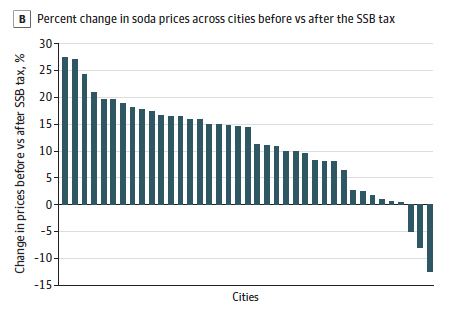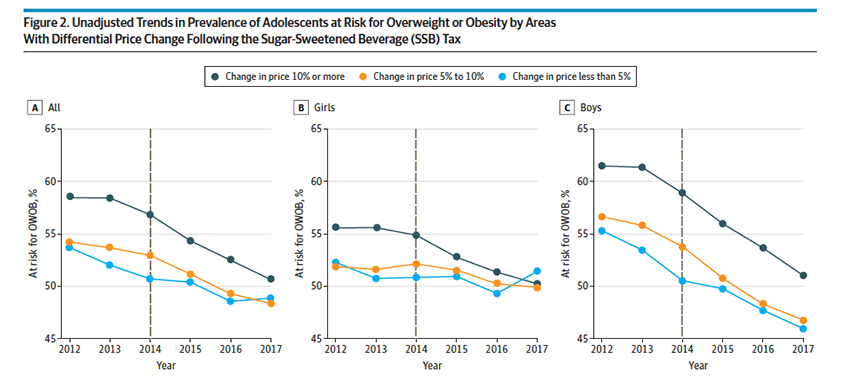The study by the RAND corporation looked at soda consumption and health records from 2011 to 2016 in Mexico, probably the first place where a tax on sugar-sweetened beverages (SSB) was instituted. The subjects, adolescents age 10 to 18 (the article is published in a pediatrics journal), whose health records are maintained by the Instituto Mexicano del Seguro Social – a health service for more than 50% of the population, primarily urban and middle class.
The price of SSBs was matched to the subjects' homes; this is a population study, and no data will speak to causality; the best we can expect is association. Even that may be a bit tenuous since we have little information on the SSB use of the subjects. The subjects were 12,654 urban adolescents, 54% girls.
 Before implementing the tax, the median age of the subjects was eleven. Half, 46 %, were overweight or obese (OWOB), and another 10% were “at risk,” defined as a BMI in the 85% percentile for their age. Overall, taxation increased the price of SSBs by 10%, but as the graph indicates, the prices varied widely across the various cities involved. As you might expect, cities with the greatest increase in prices due to taxation also had more OWOB or at-risk adolescents. The outcomes in terms of weight loss were characterized by year; one or two years lagged since the institution of the tax in 2014. The unadjusted results are depicted here.
Before implementing the tax, the median age of the subjects was eleven. Half, 46 %, were overweight or obese (OWOB), and another 10% were “at risk,” defined as a BMI in the 85% percentile for their age. Overall, taxation increased the price of SSBs by 10%, but as the graph indicates, the prices varied widely across the various cities involved. As you might expect, cities with the greatest increase in prices due to taxation also had more OWOB or at-risk adolescents. The outcomes in terms of weight loss were characterized by year; one or two years lagged since the institution of the tax in 2014. The unadjusted results are depicted here.

- For girls, after two years, there was a statistically significant decrease in weight among the obese by 1.3%, and among those at risk, also 1.3%. This amounted to roughly three-quarters of a pound over two years.
- For boys, there was no statistically significant change in weight
- For all children not at risk, there was no significant weight change
Finding the silver lining
A tax on SSBs clearly results in higher prices and reduced consumption, but its effect on weight, at least to me, seems minimal. Perhaps I can take solace in the unstated belief that the tax did not increase weight. Here is what the researchers had to say,
“… this study adds evidence that increased SSB prices at this time were associated with decreased OWOB prevalence among adolescent girls. A small but significant decrease in BMI percentile was observed for girls with heavier weight, and improved weight related outcomes were observed largely in cities where price changes after the tax were greater than 10%.”
“Small but significant” refers to a statistical value, not a clear health benefit. The weight loss experienced by the girls averaged 7.8 calories a day – roughly an eighth of a glazed Munchkin. The silver lining comes from the fact that many weight losses occurred in cities with higher taxation rates. To achieve the “reduction in mean BMI of 1% to 5% is needed to achieve a meaningful improvement in health,” we simply have to raise the tax higher. According to their linear regression, a 17% tax rather than the 10% tax would get us to that 1.1% reduction in BMI – of course, based on the study, that would only apply to the girls.
The editorial accompanying the article makes the same case, increasing the taxation.
“This study’s results, together with evidence from other jurisdictions, support setting a higher tax rate (20%-40%) to produce more substantial improvements in health. Use of tax revenues to fund synergistic policies and programs like warning labels, healthy defaults, healthy food, and beverage access, and SSB media campaigns is important, as taxes alone cannot reverse the high prevalence of obesity and type 2 diabetes globally.”
The study has many limitations; even the associations they draw are subject to significant uncertainty. We have no information on the diet or exercise of the individuals, let alone their intake of SSBs. It is tough to conclude that higher taxes would be better because it is difficult to conclude that taxation has conferred any health benefit unless it is your worldview. At best, we might say there is the possibility that for girls, a tax on SSBs may keep their weights from rising, maybe.
Taxation, along with an extensive educational push, and significant sales restrictions (even if not always followed), has significantly reduced tobacco use. The list price for a carton of cigarettes in NY is $51.24 – that includes its manufacture and all the advertising that goes along with it. The minimum sale price in NY is $105.52; of the $54.28 difference, 80% is tax. Based on that experience, the cost of SSBs needs to rise significantly, nearly doubling, and there will have to be age restrictions to see any significant health benefit.
Taxation is easy, especially if it can be blamed on non-elected officials and “science.” But if we are truly serious about our rapidly increasing waistlines, then this study demonstrates that we cannot tax ourselves into serious weight loss.
Source: Changes in Weight-Related Outcomes Among Adolescents Following Consumer Price Increases of Taxed Sugar-Sweetened Beverages JAMA Pediatrics DOI: 10.1001/jamapediatrics.2021.5044




